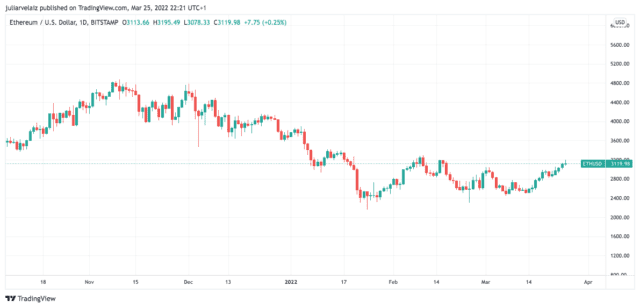The Ukrainian Ministry of Digital Transformation just launched the Meta History NFT Museum.
“WE WILL NEVER LET ANY SINGLE DAY OF THIS PERIOD DISAPPEAR FROM THE LEDGER OF WORLD HISTORY.” – The Meta History Museum of War
The mission of this NFT museum is “To preserve the memory of the real events of that time, to spread truthful information among the digital community in the world and to collect donations for the support of Ukraine.”
“A chronology of events of the Ukrainian history of modern times, set in stone.”
While Russia uses tanks to destroy Ukraine, we rely on revolutionary blockchain tech. @Meta_History_UA NFT-Museum is launched. The place to keep the memory of war. And the place to celebrate the Ukrainian identity and freedom. Check here: https://t.co/IrNV0w54tg
— Mykhailo Fedorov (@FedorovMykhailo) March 25, 2022
Reportedly, each NFT will cost 0.15 ETH and all profits will go to support the army and civilians.
It immediately caught my attention that the modern representation of major events might have become far more fluid than it used to be. We have gone from this:

To this:


And from this:
To this:

Despite the craze, many people are still skeptical of NFTs and discredit their use. Some believe they are silly or speculative. Some see them as art, others as a financial tool. Now that they are being used in a museum as both a financial tool and historic archive of the ongoing war, could we also start to talk about NFTs as valuable documents of history?
Related Reading | Ukraine Legalizes Crypto, How This New Law Could Increase Donations
What An Historian Thinks Of NFTs
In a conversation with Bitcoinist, the photographer and Ph.D. student of history Carlos Arvelaiz gave us insights into how art and pictures have been used to preserve and document the memory of events, and dug deeper into NFTs through historians and theoric concepts.
First, we talked about how NFTs as digital creations could be redefining the concept of what is art nowadays. “The concept of ‘art’ will always have to be defined from a theoric point of view to a commercial one. Some people do not consider Banksy to be an artist,” Arvelaiz said.
“The subjectivity of defining ‘art’ is prone to different forms of manipulation.”
But taking it to the field of history, he explained that “photography is a historic memory because it’s a document,” and added that “it took a while for it to be considered a document for historians. Nonetheless, its documentary characteristic reaches an aware maturity pretty quickly.”
Arvelaiz explained that up until the XIX century, historic documents were restricted to the political and economic fields of history. Then, in the XX century, because of the french school’s wider conception of history, art and photography begin to have a role as relevant documents as well.
“It does not matter whether photography is objective or not, what matters is it’s there and I have to use it.”
He explained that what is important to historians “is the methodology used so photographs can actually tell us something truthful,” question them and see if they’re not telling us something.
He added that “Photography is not a historic memory because it tells us something, but because it is portraying a moment.” And import events can be slowly portrayed by many mediums, “even a cooking recipe.”
For this reason, he thinks that “an NFT has different ways to become historic memory.” One is the fact that they are thriving during quite an interesting moment in history.
“It is a privilege to live in a moment in which the world is experiencing an ongoing change.”
“This ongoing change will be analyzed in future years through ‘those [NFT] monkeys’. It does not matter if they’re pretty or not,” nor the increase in their value or speculative aspects,” Arvelaiz explained and added that “What matters is that they were the protagonistic symbol of the change. And that turns them into a document of historic memory.”
“If we see it [NFTs] from the point of view of campaigns, promotion, propaganda, and manipulation, we should also see ‘art’ itself. With the exception of rock art, art has always been speculative, and the ones who have succeeded in dominating its market have done it by guaranteeing a certain message.”
Regarding the NFTs launched by the Ukrainian government, Arvelaiz believes that “its propagandistic characteristic is very interesting because what is looking for is support and solidarity,”
He added that “what this is telling you is ‘this exists and I am leveraging a world that is giving me more opportunities to find financing than what the French, German, and Jewish resistance could find during WWII.’”
“What wouldn’t have achieved Anne Frank creating NFTs while hidden in Amsterdam? Without any kind of technology alike, look at what she achieved with a private diary. Somehow, that makes you understand how important this moment is.”
Related Reading | Ukraine Has Received $108 Million In Crypto Donations Following Kraken And BAYC Donations


